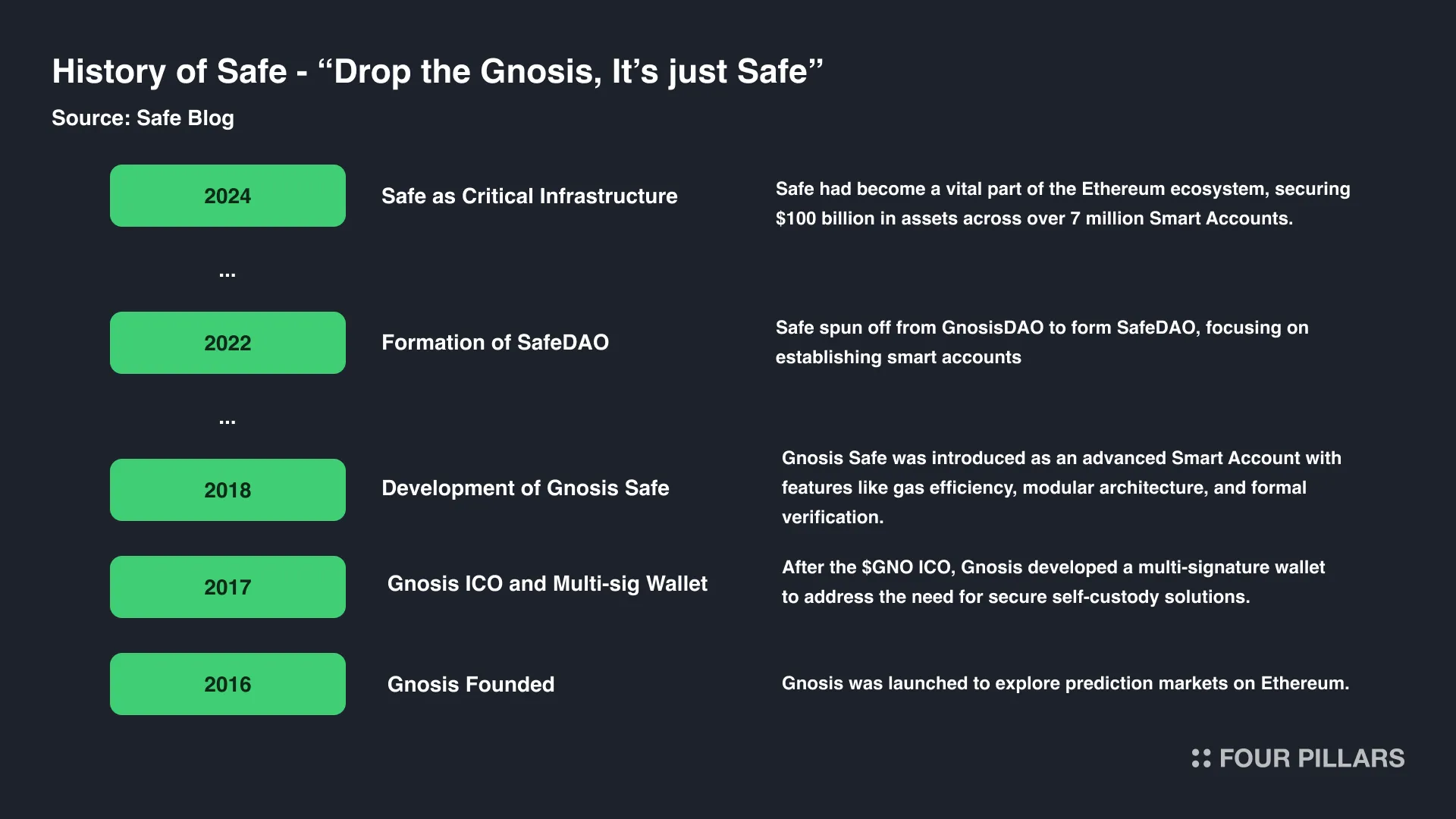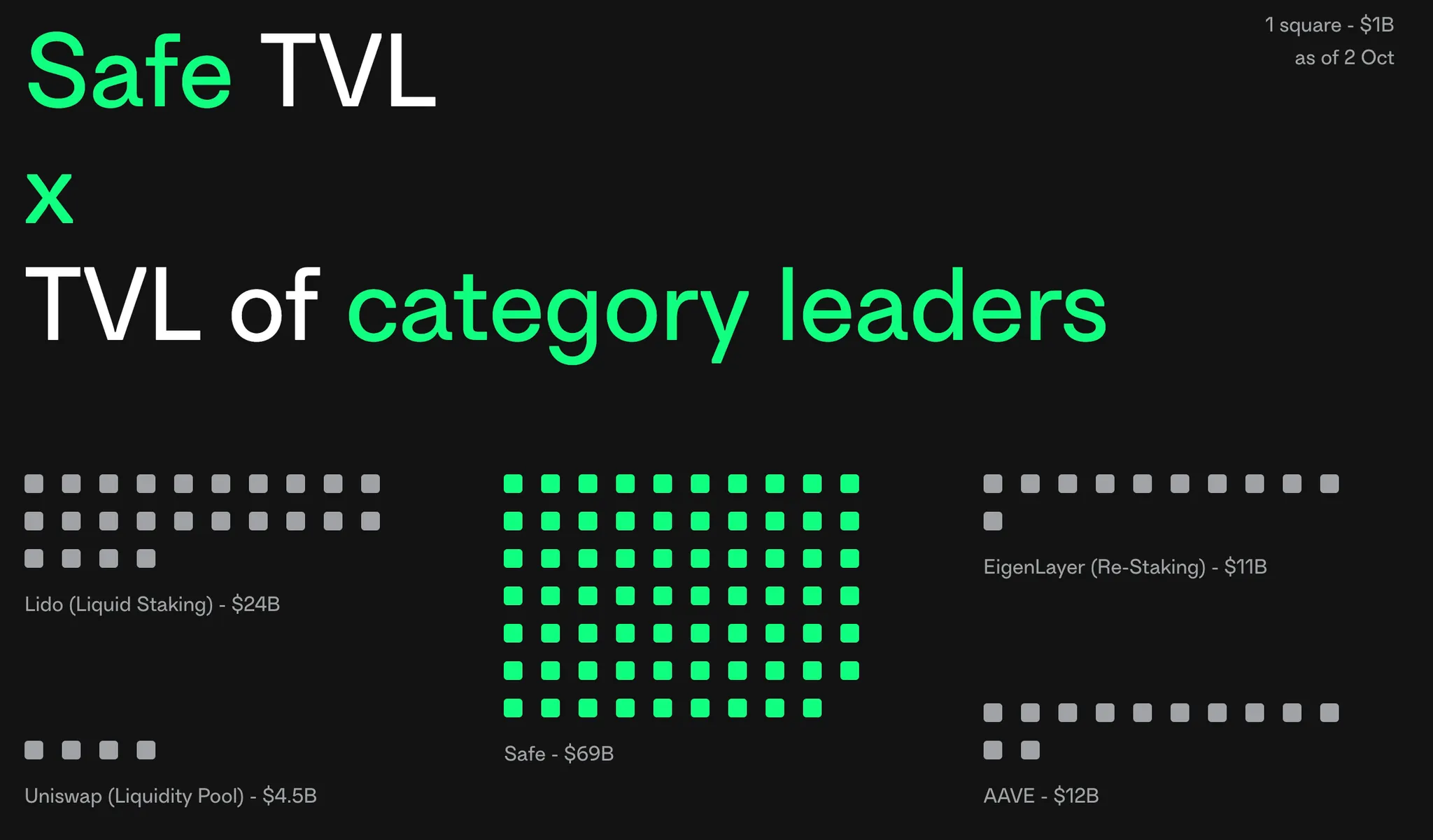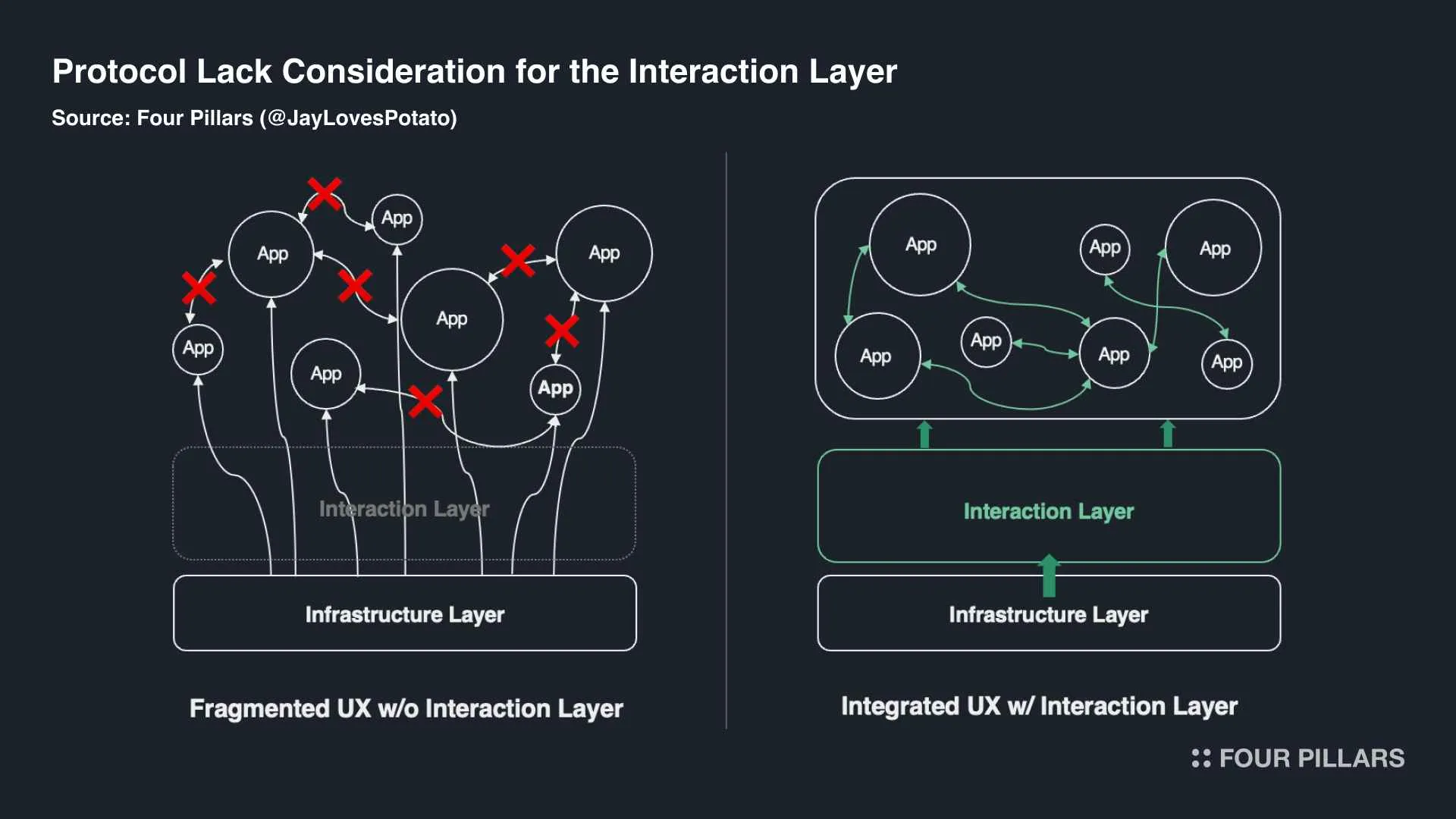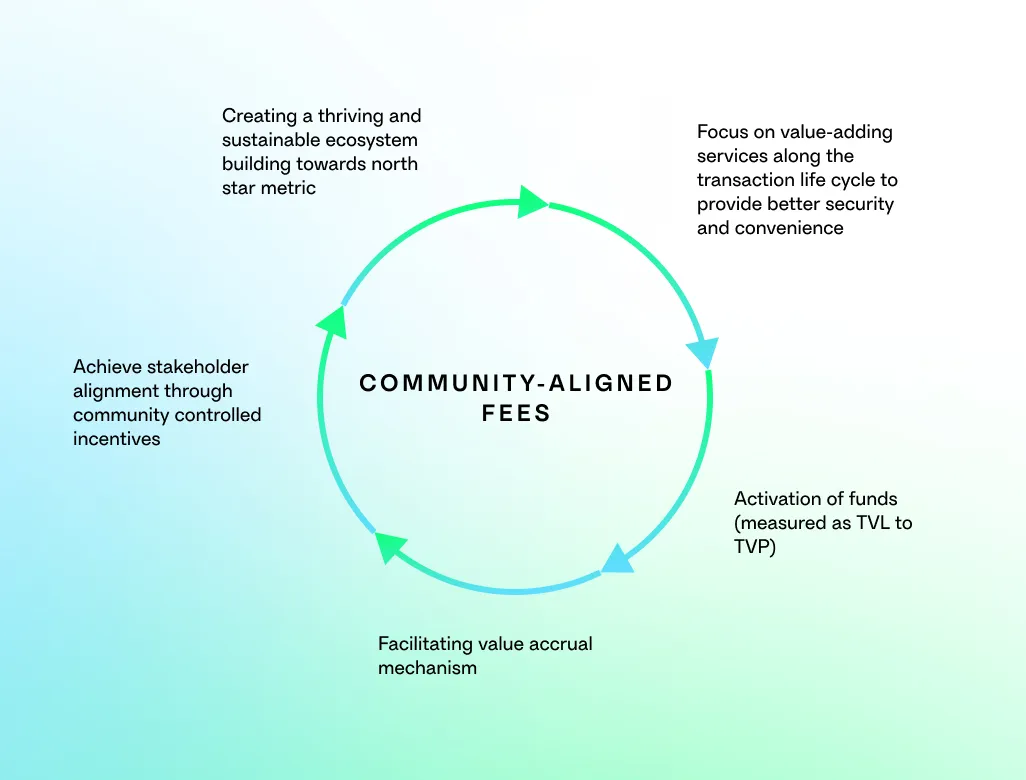Safe has a long history: it started in 2017 as an in-house multisig solution for the Gnosis token sale and has spun off from Gnosis over the years and now offers various product lines using the $SAFE token and SafeDAO to coordinate them.
Currently, Safe secures around $70B in crypto assets, surpassing the combined holdings of OKX and Robinhood. However, Safe is more than a multi-sig wallet. Safe's vision is to become the "Ownership Layer of Crypto."
However, for Safe to maintain the market share, they should focus on three keywords: Mobile, Chain Abstraction, and $SAFE token utility.

Source: History of Safe: From Gnosis Safe to beyond | Safe
Safe, formerly known as Gnosis Safe, began as an internal project at Gnosis in 2017. It evolved from a multi-signature wallet into a smart-contract-based wallet in 2018. Despite early adoption challenges, it gained popularity among DAOs, market makers, and high-net-worth individuals.
In 2022, Safe separated from GnosisDAO to form SafeDAO, with the goal of making smart accounts the standard for web3 interactions. By 2024, Safe had secured $100 billion across 7 million Smart Accounts, becoming the go-to smart wallet in the Ethereum ecosystem. It is now used by various projects, including Worldcoin. It now holds around $70B across its products, which is more than Robinhood CEX and OKX.

Source: X (@safe)
The Safe product suite provides using and developing smart account functionalities with an improved security and better user experience. It aims to replace traditional EOAs, a wallet controlled by a private key without additional functionalties, with advanced smart accounts. Here's an overview of the key products:
1.2.1 Safe{Wallet} - Multi-signature Wallet for “Users”
Safe{Wallet} is a popular multi-signature wallet for asset management. It's favored by DAOs for its security, requiring multiple signatures for transactions. The wallet supports numerous networks including Ethereum, Polygon, and Binance Smart Chain. As an open-source, non-custodial solution, Safe{Wallet} has provided various add-on features. It offers features like transaction simulation, customizable security, and social recovery.

Source: Safe Data Room - Key Insights into the Safe Ecosystem
1.2.2 Safe{Core} - Account Abstraction Stack for “Developers”
The Safe{Core} SDK simplifies account abstraction integration with third-party services. It streamlines smart contract account setup and management through four interconnected kits:
The Starter Kit simplifies account deployment and transaction management.
The Protocol Kit enables interaction with Safe Smart Accounts, including account creation and transaction handling.
The API Kit facilitates interaction with the Safe Transaction Service API which provides information about transactions.
The Relay Kit enhances transaction efficiency through various payment options and gas-less experiences.
Safe's vision centers on the Safe Ownership Layer, built around the Safe Smart Account. This layer will act as the layer where assets are handled and stored. Safe{Core} provides developer tools, while Safe{Wallet} allows users to use smart account features like multisig functionality and social recovery.

Source: The Safe Case #2: Digital Ownership in Your Pocket | Safe

Source: Dune (@safe/Smart Accounts Landscape)
Safe currently leads the smart wallet market with impressive metrics:
7.3% of all USDC is stored in Safe
9.4% of Cyberpunk NFT is stored in Safe
1.33% of onchain transactions originate from a Safe Account
Safe's Total Value Locked (TVL) is $69B, compared to centralized exchanges (CEX) like Binance ($105B), OKX ($18B), and Robinhood ($12B)
Safe's multi-signature wallets appeal to organizations handling large funds, reducing unauthorized access risks. In the overall market, Safe manages 60.56% of smart account transactions and accounts for 99.49% of the TVL at $73.31 billion. However, it faces competition from other smart wallet providers like Biconomy, Pimlico, Zerodev, and Alchemy, which also address various developer pain points. In terms of number of deployment, Safe accounts for 38.02%, while Alchemy leads with 40.40%.
The future of smart wallets is promising, with growing demand for secure, convenient solutions. Safe's current dominance provides a strong foundation, but maintaining this advantage will require continuous adaptation. As Safe has been open-source with numerous developer tools, it has been one of the best options for developers trying to implement smart wallets. Recent examples include the Worldcoin wallet and Autonolas' AI agent wallets.
However, as competition intensifies, developer experience, and integration capabilities will determine which providers would thrive.
Safe's vision is to become the Ownership Layer of Crypto, serving as the go-to solution for DeFi, payments, and other crypto applications. This layer will secure asset management and signatures.
Currently, navigating the crypto landscape is challenging due to unreliable information, rampant phishing scams, over 300 blockchains, and fragmented assets across these chains.
Two key areas are crucial for Safe's success:
Multi-Chain Management Abstraction: Implementing Chain Abstraction infrastructure is vital to simplify user navigation across multiple blockchains. Safe has initiated research through Safe{Foundry}, and announced a gasless deployment with the same address across 15+ blockchains. This is the first implementation of Chain Abstraction features, with more developments in progress.
Mobile Market Penetration: As mobile becomes the battleground for user acquisition, two approaches stand out. Building custom mobile wallets for specific dApps (e.g., Uniswap Wallet). Second is Developing a mobile app store with an in-app browser (e.g., Zerion). While Safe has its own mobile wallet, the mobile experience remains limited. To truly become the ownership layer of crypto, Safe must prioritize capturing mobile users.

Source: X (@JayLovesPotato)
Token is the product in crypto. It makes the community more loyal and is central to the sustainability and operation of the DAO.
Currently the primary utility of the $SAFE token is governance. Token holders can participate in SafeDAO's decision-making processes, voting on proposals. This includes voting on resource allocation, ecosystem expansion, and modifications to the SafeDAO Constitution.
Which means, not much value accrual is happening. Recently, there have been some discussions on adding utilities of $SAFE. As the utilities are added, SAFE has a potential to become the representative token of the “Ownership Layer of Crypto.” Potential utilities could be like below:
Fee from Internal Swaps[This is now Live]: One potential solution to enhance $SAFE token utility could involve implementing fees on internal token swaps within the Safe{Wallet}. Given the significant swap volume - averaging $450 million per month since June 2023, with nearly $1 billion in March alone - this could provide a substantial utility boost for the $SAFE token. (Source).
Staking Mechanisms: Proposals have been made to implement staking mechanisms. For instance, one suggestion involves protocols staking a fixed percentage of SAFE tokens to be included in an integration queue for the Safe front-end. (Source)
Safe Activity Program: This program aims to introduce an activity-related use case for the SAFE token. By locking $SAFE tokens, users will be able to boost rewards earned from their participation in the Safe ecosystem. (Source)

Source: Safe Data Room - Key Insights into the Safe Ecosystem
The utility of $SAFE presents another challenge for the SafeDAO ecosystem. As the project shifts its focus towards an account-centric view and the activation of funds, the role of $SAFE becomes increasingly important. The community is now tasked with developing and implementing use cases that not only enhance the token's utility but also align with the ecosystem's strategic goals. This approach aims to create a symbiotic relationship between token holders and the platform's growth, ensuring that $SAFE's value is intrinsically tied to the ecosystem's success.
To address this challenge, SafeDAO is exploring services that facilitate user actions and can be monetized, similar to the recently introduced Native Swaps feature. These value-adding services, embedded directly into user accounts, have the potential to generate revenue streams that contribute to the ecosystem's sustainability while simultaneously increasing $SAFE's utility. By focusing on features that enhance the user experience during the transaction cycle, SafeDAO aims to create a flywheel effect where increased usage leads to higher token value, which in turn attracts more users and developers to the ecosystem.

Source: Introduction of Community-Aligned Fees
Related Articles, News, Tweets etc. :
Dive into 'Narratives' that will be important in the next year